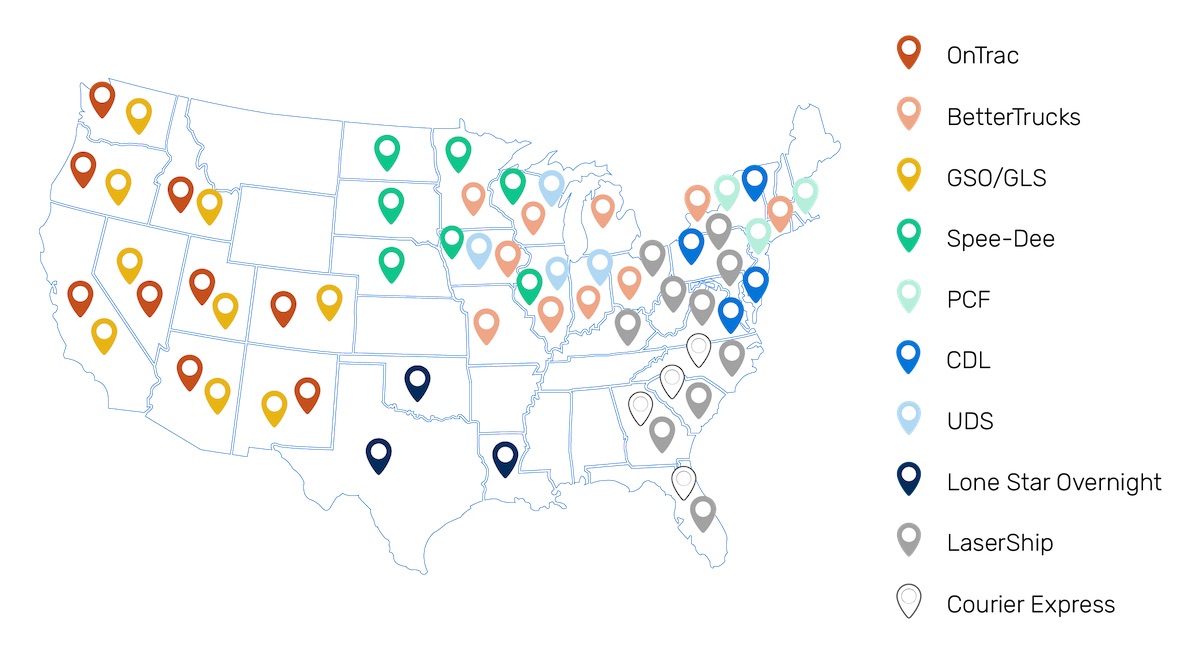Over the past year (and especially the past year), we’ve witnessed an accelerated trend toward local and regional carriers. More and more companies are entertaining the idea of utilizing not just one shipping carrier, big and national, but multiple, and of all shapes, sizes, and specializations.
But why might a company branch out into local and regional carriers? And what calculus should you employ to decide if you should? Before deciding which carriers to use, you need to know the difference between national, local, and regional carriers.
What is a national carrier?
A national carrier provides shipping services across an entire country, covering large geographic areas with standardized delivery networks. They offer a range of services, including ground, air, and freight shipping, and are often relied upon for cross-country or long-distance deliveries. The most popular national carriers in the U.S. include USPS, UPS, FedEx, and DHL.
What is a local carrier?
A local carrier is a delivery company that operates within a specific city or small geographic area, specializing in same-day or next-day deliveries. They often handle short-distance shipments, such as restaurant deliveries or local business parcels.
What is a regional carrier?
Like local carriers, regional carriers are delivery providers that cover a limited geographic area within a country. However, regional carriers have a wider reach than local ones, often offering delivery across several states. These regions are often segmented in familiar ways: Northeast, Midwest, or the South, for example.
Regional carriers stand in contrast to the big nationals like FedEx and UPS, as well as to their hyper-localized carrier cousins (like Jitsu or Bond) that operate, often with same-day service, within select metro areas throughout the country.
Which carriers fit this definition? On EasyPost, it’s a smattering (and always growing!). Collectively, you’ll notice they’re nearly exhaustive. To highlight a few, BetterTrucks, Courier Express, and PCF are some of EasyPost’s newest and shiniest additions, due to customer demand.

Why do shippers use local and regional carriers?
Local and regional carriers are essential players in the logistics world, particularly for businesses that need to ship within specific geographic areas. Their narrower focus allows them to offer faster, more efficient delivery services, often at a lower cost than their national counterparts.
Faster deliveries
Just about every bonafide local and regional carrier either offers a next-day delivery option, or knows no other way. Some that span a wide stretch of states might also offer two-day delivery, and others—perhaps with high urban density—might also offer same-day. The common denominator, though, is that they’re going to get it (whatever “it” is) there (wherever “there” is) fast.
Furthermore, because these carriers are smaller, they’re able to plan their capacity more meticulously. So they’re less likely to get blown around in the winds of volatile market demands and, as a result, their transit times are often more stable.
Looking at EasyPost’s proprietary time-in-transit data, take CDL in the Northeast and UDS in the Midwest as a combined example. Across the 1M+ shipments they collectively handled for EasyPost customers over the past wrench of a year, at no point did their weekly average transit time exceed 1.5 days.
And between the two carriers, for only one week in the past year could you not expect at least 80% of your shipments to arrive the next day. Rather, for most weeks, you could expect at least 97% of your shipments to arrive the next day.
Cost savings
It must be expensive, huh? Well, this is the real kicker: local and regional carriers are often less expensive than their national counterparts. This is in large part thanks to the very same thing that might for some be a detraction: their narrowed scope. They don’t have to (or purport to) do it all, so they can instead focus on the highest leverage lanes, which drives down the cost-per-transit-day.
Handling high-demand periods
During high-demand periods, when national carriers often face capacity constraints, local and regional carriers become invaluable. They offer businesses a backup plan, ensuring that shipments continue to move smoothly even when the big players are overwhelmed.
This redundancy not only prevents delays but also helps businesses maintain consistent service levels, particularly during challenging times like the COVID-19 pandemic.
Reliability via redundancy
But no one ever replaced a big national carrier with local or regional ones. Even in the extreme case, with an exhaustive patchwork of these carriers, there would be gaps. Namely, even if every state in your network was covered by a regional carrier, it would require every region to have an origin point. There can be no shore-to-shore shipping via regional carriers.
Instead, local and regional carriers are most often of supplemental value. In March of 2021, exactly 50% of EasyPost customers who shipped at least 100 packages used more than one carrier. Of those who shipped at least 1,000, 65% used more than one carrier. (These figures are lower-bound conservative, too, as EasyPost doesn’t always house all of a given customer’s shipping volume.)
To the extent that they’re not constrained by volume-dependent discounts, shippers can find value in diversification. Especially during COVID, having a single point of failure was a scary prospect for many. It became increasingly important to avoid being overly reliant on any one carrier. Regional and local carriers were a natural salve for this: if transit times should spike or oscillate for one carrier, having a backup tempers that. For others, adding regional carriers was a safeguard against unpredictable capacity throttles: if business was booming faster than your carrier could accommodate, you needed a release valve. Regional and local carriers acted the part here, too.
In every case, for a growing number of shippers, these smaller carriers have become a vital stabilizer, a driver of efficiencies, or both.
Ship from where the orders are
If you have just a single fulfillment location and your demand is highly dispersed, local and regional carriers probably won’t make sense for you.
Conversely, if you have more than one fulfillment location and/or tightly concentrated demand centers, then the regional approach (as a complement to your preferred national carrier) is definitely worth looking into. Minimize the distance your products must travel, and the same will happen for transit times, cost, customer complaints, etc.
As consumer expectations become more and more demanding, heaps of localized solutions are cropping up to match them. Shippers no longer have to settle for long and costly transit times to the complete opposite side of the country—and their customers won’t settle for it.
Easily ship with your favorite local and regional carriers
While national carriers might dominate the headlines, local and regional carriers quietly deliver exceptional service where it matters most—close to home. By integrating these carriers into your logistics strategy, you can achieve a more balanced, reliable, and cost-effective shipping operation.
The EasyPost Shipping API makes it simple to integrate with dozens of national, regional, and local carriers, allowing merchants to create a multi-carrier shipping strategy that works for them. You’ll be able to quickly add new carriers, automatically choose the fastest and most affordable shipping methods, generate labels, and more.


